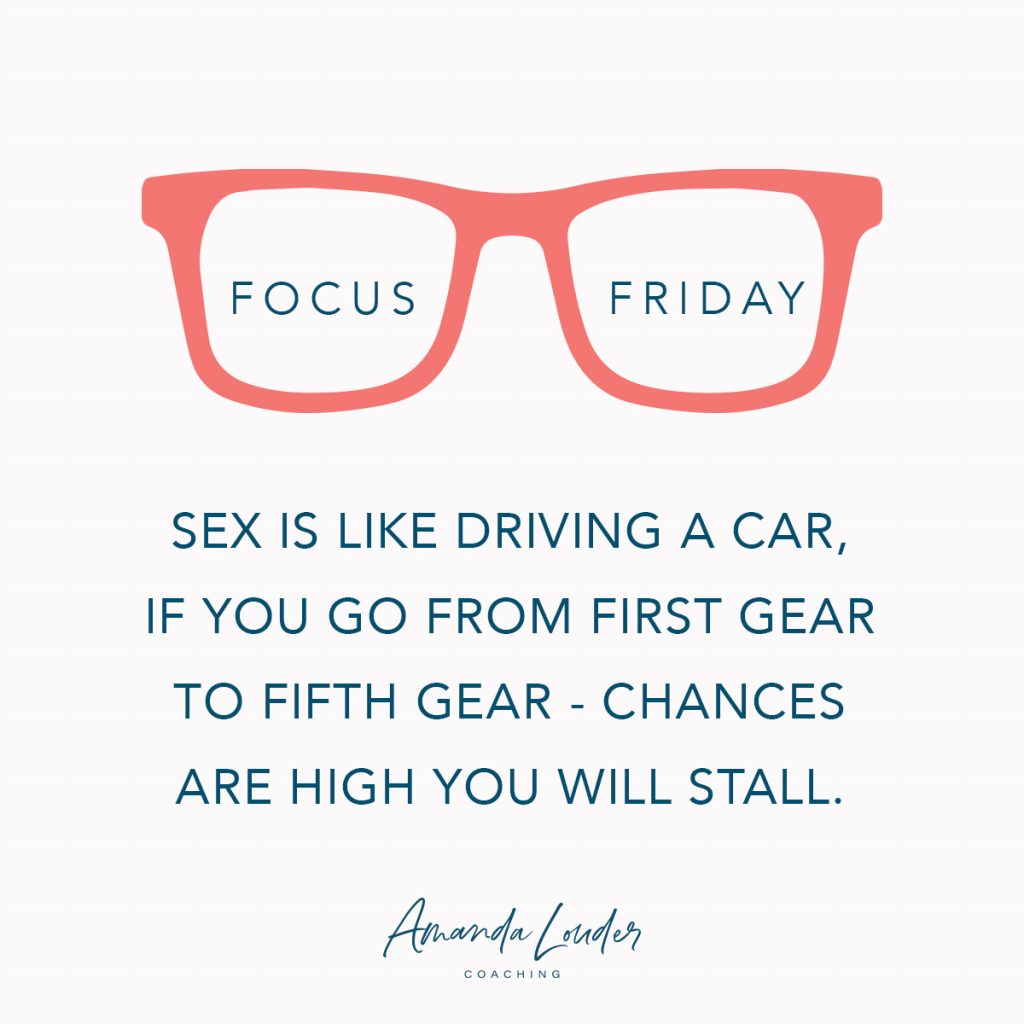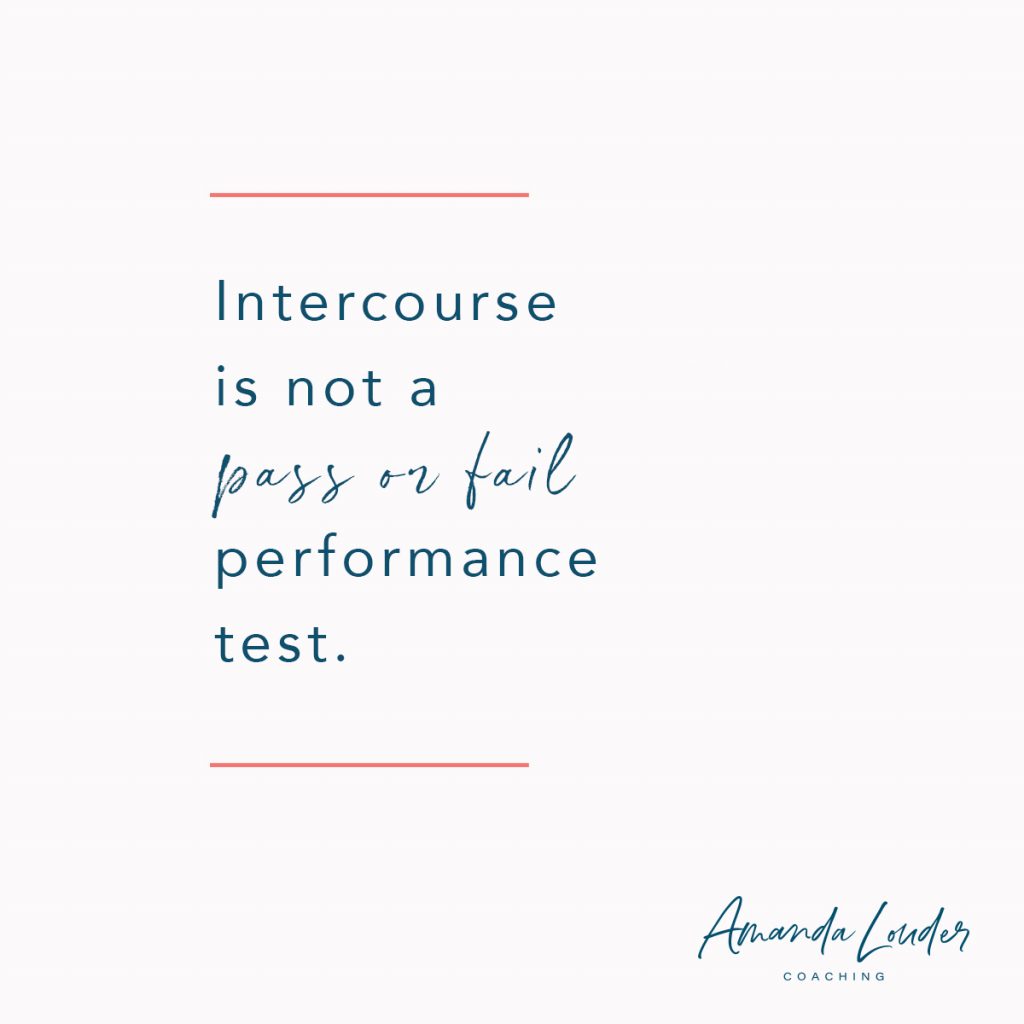
Today, I’m going to discuss the five gears of touch by Barry W. McCarthy – a certified sex and couples therapist. Gear 1 begins with affectionate touch and gear 5 is intercourse. I will teach you the value of each level of touch – and how slowing down and moving forward together through these gears will propel your sexual relationship to a whole new level. Learn more and get show notes here: https://amandalouder.com/podcast/137/
Download your FREE Worksheet!




Show Notes:
Follow Amanda on Facebook and Instagram.
Join Amanda’s Private Facebook Group.
References for this episode:
Show Summary:
With very little sex education and being scared to look up and try new things, most couples find themselves having to guess what might work for them when it comes to sex. And once they find something that works, it leads to doing the same thing each and every time without much variety…which gets BORING!
The majority of couples only develop a couple of things in their repertoire which usually leads to dissatisfaction in the bedroom. Men tend to overly focus on orgasm and too many women are just complying with their orgasm focused experience. Both are missing out on a lot of other experiences that can bring connection, intimacy, and pleasure.
Today, I’m going to discuss the five gears of touch by Barry W. McCarthy – a certified sex and couples therapist. These five gears can bring a new set of skills into your sexual menu. They can be focused on enhancing sexual desire and pleasure. They can help increase awareness of each partner’s preference for various gears.
Most couples fall into the trap of only using 2 gears; affection and intercourse. Couples often correlate affection with intercourse, which result in lower levels of both touch and sex. So, to improve your sex life, you need more touch. But believing that sex equals intercourse is so limiting! Sex is a lot more than intercourse. So, if you want to heat things up, it’s time to start slow and then slowly increase your touch. Each gear should increase the pleasure and arousal of both partners, which is why it’s important to start slow and work your way up.
First Gear
First gear is all about affectionate touch. This usually involves clothes on touching, such as holding hands, hugging or kissing. Affection touch is not considered sexual, but it provides the foundation for intimacy.
This is often a missing piece for many women. They crave non-sexual affectionate touch by their spouse, but too often the husband has rushed to third gear, which we will talk about more in a minute. But we need affectionate touch to get us ready to move into a higher gear.
If you think about driving a car, you can’t start out in gear 3, 4, or 5. You’ve got to work your way there. It’s the same with these 5 gears of touch. The more time you spend in first gear, the easier it’s going to be to move on.
If you think about it, when you were dating and engaged, you spent a lot of time in first gear, which is what drove the desire levels up. It begins to create that arousal and that sexual tension.
Arousal Score: 1
Second Gear
Second gear is all about sensual touch. This involves non-genital pleasuring which can be clothed, semi-clothed, or done in the nude. Sensual touch includes head, back, or foot rubs; cuddling on the couch while watching TV or a movie, cuddling as you go to sleep or wake up. Sensual touch is an integral part of a couple’s sexuality. It has value in itself as well as a bridge to sexual desire. This gear is all about awakening the senses.
Arousal Score: 1-3
Third Gear
Third gear is all about playful touch. This gear mixes genital pleasuring with non-genital touch. Playful touch can include touching in the shower or bath, a full body massage, seductive or erotic dancing, sexual games like strip poker or Twister. What makes playful touch inviting is the enhanced sense of pleasure and playful unpredictability. Again, it can be valuable by itself or as a bridge to more sexual desire.
But this is also the gear where I see getting in the way of couples truly connecting. Too many times husbands are in third gear while their wife is back in first gear. I hear of too many husbands thinking it’s fun to touch or grope their wives when they haven’t worked their way up to that.
Don’t assume that because you are in a certain gear, your spouse is as well. It’s always important to go down to where your spouse is and work up together.
Arousal Score: 4-5
Fourth Gear
Fourth gear is all about erotic touch. This is all about touching each other without intercourse. This can include manual stimulation, oral, rubbing, or vibrator stimulation. This is all about driving arousal, with or without orgasm. Again, this is about sexual play.
This gear can often be a challenging gear for many couples. Men tend to want to jump to intercourse because they know that feels good. But spending time here can provide couples with vitality, creativity, and novelty that they need to keep the vibrancy of their sexual relationship. It’s also where it tends to be the most pleasurable for women and where they get their orgasm.
Plenty of time should be spent in fourth gear before moving on.
Arousal Score: 6-10
Fifth Gear
Fifth gear is intercourse. If the other gears are done well, intercourse can be the pinnacle of a couple’s time together. Not because that’s when the man can finally have his orgasm, but because it is literally the joining of two body’s in a way that nothing else can.
Intercourse can be a natural continuation of the pleasuring and erotic process. Too often though it looks like a pass-fail sex performance test. By changing the way you look at the other gears, taking orgasm as a goal off the table, and focusing on mutual enjoyment and pleasure, that is when it can truly be great.
Arousal Score: 7-10
I find that a lot of couples, when they get into third or fourth gear they have problems. They have a hard time getting or staying aroused. They have a hard time staying present in the moment. So they quickly move into fifth gear to get things over. Well think about if you are in 2nd or 3rd gear and try to shift into 5th gear…you are going to stall out. So it’s really important to work your way SLOWLY up through the gears. Spend time in each gear making sure both partners are in the same place.
If you find yourself jumping to 5th gear quite often, I suggest taking intercourse off the table for a while. Stay in gears 1-4 working on finding sexual pleasure together in each. Ask yourself the question – “If there was no intercourse, what would we do?” This really opens up the door for more sexuality in your every day life. If you think everything has to end in intercourse that can be a struggle for many couples. They often think that if intercourse isn’t available, then all playfulness and sexuality is off the table. This is what I find very common in many women. That because they don’t want intercourse they turn off all sexuality and shut down sexual advances. But if you think “we can engage in sexual play and it doesn’t have to end in intercourse,” then they will have more sexual play. And all of the sexual play is valuable. You can start or stop anytime. It’s not a second rate sexual experience, it’s just a different kind of sexual experience. So if you aren’t in the mood for intercourse, what are you in the mood for? Or what can you be open to? When you can find fun, playfulness, connection, intimacy in other ways besides intercourse, that is when things really heat up and get good.
I have created a worksheet for you to help facilitate a conversation between your and your spouse about touch, pleasure, and sex. Have your partner listen to this episode and then print out a copy for each of you. Separately, chart out the percentage of each gear of touch you currently experience and then what percentage of each you would like to experience. Once you’ve both filled out your charts, compare and discuss your results together. You can find the worksheet on AmandaLouder.com/podcast/137



